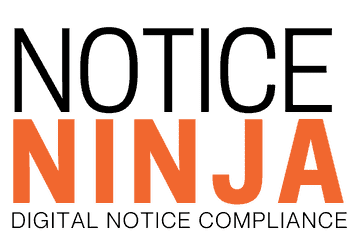Yes, NOTICENINJA is corporate tax notice compliance software that automates key workflows including notice assignments. The platform employs a rule-based system that can manage multiple level rules and ensure notices are directed to the appropriate stakeholder. As a result, you’ll never have to worry about notices being misdirected or slipping between the cracks.

Process Mapping Is Where Tax Automation Succeeds Or Stalls

12 August
This framework helps leaders uncover where assignments stall and how to realign workflows across teams.
It usually starts with one missing notice. Then a follow-up. Then a penalty. Then a meeting.
By the time a VP of Tax is pulled in, it is rarely about one mistake. It is about how work is moving, or not moving, inside the team. Someone thought it was assigned. Someone else assumed the vendor handled it. Another person did reply, but the response was stored in a separate file, disconnected from the rest of the workflow.
The tax team is not broken. It is just working without a clear map.
Where Automation Often Breaks Down
For corporate and private equity tax teams, automation is often introduced to solve for speed and scale. But what gets missed is that tools only accelerate what already exists. Handoffs remain incomplete, roles stay ambiguous, and process blind spots go unnoticed.
Before technology is introduced, most tax notice workflows include:
- Manual data entry from scanned CP504s, NYS-45s, IL-W-3s, amended returns, or refund checks
- Task ownership that shifts when staff turnover, restructure, or scale without documentation
- Email and spreadsheet-based tracking with no unified source of truth
- Reporting that requires manually combining files, logs, and updates across departments
The result is that tax leadership lacks visibility into where breakdowns occur across high-volume entity structures.
In a recent accounting professional survey, 79 percent of tax and accounting teams said they spend too much time tracking internal files. Nearly half described their workflows as fundamentally inconsistent. In multi-entity environments, these delays not only increase response time. They also compound audit exposure, missed refunds, and cost-center misalignment.
A Better Place To Start Than Software
The real opportunity is to begin with process mapping.
If your team wants faster response times, stronger documentation, and fewer escalations, the first step is not picking the right system. It is understanding how your team currently moves work from intake to resolution.
You do not need to automate everything at once. You need to fix what breaks at the handoff point.
What Leading Teams Are Doing Differently
Tax leaders at high-volume corporate and PE-backed firms are beginning their automation journey by building internal alignment first. They are:
- Standardizing task names for research, abatement, and escalation
- Creating shared access with permission-based rules
- Assigning work based on role, notice type, and entity structure
- Linking recurring notices to prevent duplicated effort
- Using dashboards that track time to resolution, not just volume
One VP of Tax described the shift this way:
“We weren’t lacking tools. We were lacking a clear system to move work forward. Once we fixed that, automation became a multiplier, not a workaround.”
Five Questions That Expose Where Tax Notice Workflows Stall
Use the following prompts to facilitate a process mapping session across tax, compliance, and operations:
- What happens after a notice is received? Who opens it, where is it stored, and how is it logged? How long does that take?
- How are notices assigned? Does everyone know who owns what? Is there a central record of that?
- Where do follow-ups live? Are responses tracked inside a central system, or do they live in someone’s inbox or file folder?
- What happens when a notice repeats? Can the system or person handling it recognize recurring or sequential notices tied to the same issue?
- What would happen if the primary analyst left today? Could someone step in and pick up where they left off without starting from scratch?
These questions are not just operational. They are risk-facing. If one notice goes unanswered, it is an error. If the entire system cannot track what was done and by whom, that becomes a compliance liability.
Scenarios That Signal Deeper Operational Issues
Here are five common scenarios tax teams face that signal deeper handoff or ownership gaps. Each includes a typical challenge and its broader strategic impact. A complete set of diagnostic questions is included in the downloadable framework.
Scenario 1: Manual data capture and error-prone inputs
Typical challenge: Teams spend hours rekeying data from notices like CP2100As, refund requests, or amended returns. Data validation is inconsistent, and response actions are delayed.
Strategic impact on PE operations: Inconsistent mappings or miskeyed EINs during peak filing cycles can cascade across portfolio entities and affect audit posture.
Our Solution: NOTICENINJA automates intake, speeds entry by up to 85 percent, and maps subtype classifications like refunds, balance dues, audits, or POA-related correspondence to structured fields with smart validations.
Scenario 2: Lost visibility in high-volume, multi-entity structures
Typical challenge: EIN reuse, dissolutions, and mergers make it hard to track which entity owns which notice. Sequential notices and shared IDs create duplicate records and missed responses.
Implication for fund performance and oversight: With hundreds of entities under management, portfolio oversight depends on clean, entity-linked workflows. Poor visibility delays financial reporting or introduces avoidable exposure.
Our Solution: Our platform flags missing, duplicate, or mismatched accounts. Sequential notice detection links related notices across periods and entities. Up to five cost centers allow reporting that mirrors how tax leaders track performance by fund, division, or portfolio.
Scenario 3: Ambiguous task assignment and follow-through gaps
Typical challenge: Ownership is unclear. Analysts create one-off tasks or follow-ups via email. Teams lose track of who is responsible when deadlines hit.
Risk to operational continuity: Task ambiguity leads to missed response windows, impacting quarterly close schedules or triggering preventable penalties.
Our Solution: NOTICENINJA allows for bulk reassignment, role-based ownership, round-robin rules, and standardized task naming (e.g., “Escalate: CP504 Refund Delay” or “Research: CA DE 9 Penalty”). Every update is audit-tracked.
Scenario 4: Inconsistent reporting and disconnected resolution history
Typical challenge: Teams manually link duplicate or sequential notices across periods. Refund checks stall, quarterly estimates repeat, and no system ties it all together.
Strategic impact on PE operations: Unresolved notices interfere with cash flow visibility and delay treasury or controller reconciliation at the fund level.
Our Solution: Our sequential linking via a specific report highlights related notices. Dashboards track resolution time by notice type, user, or business unit — not just volume.
Scenario 5: Fragmented access and missed communications
Typical challenge: Some users have too much access, others too little. Critical alerts are missed. Collaboration between tax, finance, legal, and compliance is siloed.
Implication for fund performance and oversight: Siloed access increases the chance of unmonitored escalations, particularly with POAs, refund denials, and amended returns that touch multiple stakeholders.
Our Solution: Our platform uses configurable user groups, smart notifications. Plus, license controls make sure urgent notices reach the right people in real time.
AI + Automation Readiness
Tax automation does not fix broken handoffs. It magnifies them.
Before you invest in a platform like NOTICENINJA, the most strategic move is to map the flow of work from receipt to resolution. When teams know what happens next, leadership can make smarter investments, vendors can plug into optimal workflows, and response times improve without overhauling headcount.
Want a more structured way to get started?
We’ve developed a framework from real NOTICENINJA users to help tax teams identify where breakdowns occur and how to solve them before automation even begins.
👉 Download the Notice Workflow Readiness Framework (PDF)
RELATED POSTS
- Why Tax Rate Notices Deserve a Workflow—Not a Crisis Response
- Form 941 Filing Is Costing You More Than You Think
- Why Notice Automation Needs More Than an Inbox
